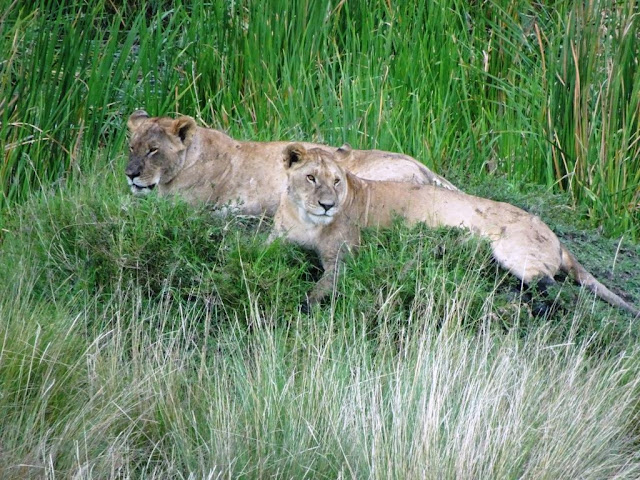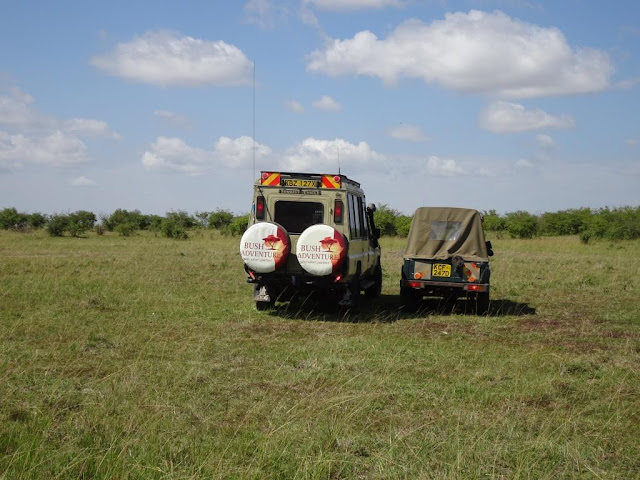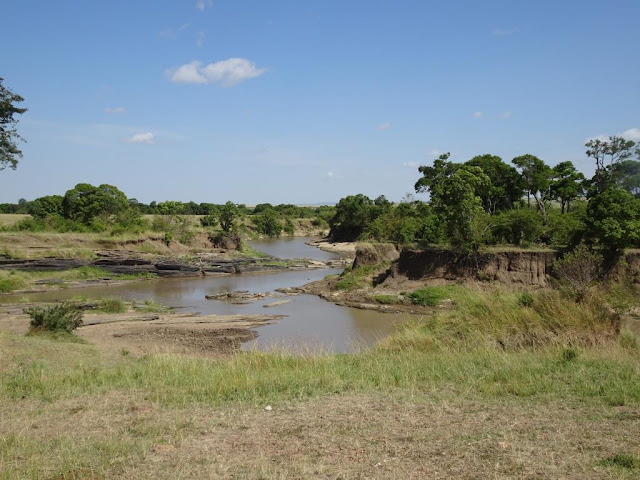When we pulled up they were scattered around the Mara River, popping in and out of the water. Adult hippos can stay submerged about five to six minutes while the babies only about 40 seconds.


After we were there for a while it was really funny to look back at them. They all turned facing us and stayed mostly submerged, in a line, keeping an eye on us. We weren't sure if they wanted to charge us but I'm pretty sure it was a defense mechanism.

Yes, that is one big crocodile!

From the river headed out in search of lions and we were not disappointed! We came upon the "Chinese" pride which had killed a hippo earlier this morning. There is an observation lodge where mainly Chinese stay that overlooks this part of the park, so that is where its name comes from. Lion prides usually maintain about a 15 mile territory. We were able to spot five females and one male who were feasting on the hippo. The hippos come out of the water in the early mornings to feed on the grass and one of them was unlucky today. You can see how muddy the lions legs and faces are.

The male was snoozing in the tall grass, resting after the hunt and feeding.


This spotted hyenna was up a small hill overlooking the lions and hippo, trying to decide if it wanted to take a chance at having bit of the hippo. It came closer and closer, but eventually moved away when the male started to get up.

We could see several scars on this guy's back when he got up.

He finally got up and wandered away from the group and settled back in at the top of the hill, near where the hyena had been!

This female made her way from the group back to the hippo. If you have a sensitive stomach, skip the next couple pictures and video.
 Morning feeding on the hippo kill.
Morning feeding on the hippo kill.
The video is of the female lion feasting on the hippo. There were three other hippos still in the water next to this kill, keeping an eye on the lions!
Lion video https://youtu.be/TiZT0zu5fu0
We watched as hundreds of zebras were running near the river and thought we might see them crossing, but at the last minute they turned back and ran the other way. Our guide said it could have been that they spotted the crocodiles and were frightened. The zebras are heading toward the river to meet the migrating wildebeest. We were in the third vehicle and stopped to watch as several zebras crossed in front of us.

Even though the "roads" are hard to see sometimes, it is against the rules to go off-road. Another vehicle came behind us and did just that hoping for a better look. Unfortunately, for him, there was a ranger coming our direction and saw him and stopped him! The ranger is in the smaller vehicle. The drivers can be fined up to $200.


The hyenas also followed the zebras. We even spotted two traveling together, but the lighter one looked much younger.


A large group of zebras is called a dazzle. They roll on the ground "dusting" themselves in an effort to keep the bugs off. It always looked like they were having a good time!

Most of the giraffes we saw today were off in the distance, but still fun to see.

We also spotted several eland. They are so large and their horns have an interesting twist to them.

The hyenas were everywhere in the park! Some of them seemed to pose for pictures and one of them seemed to be enjoying a mudbath!


Continuing on, we finally got a chance to see a cheetah up close! This was the first sighting.

We pulled closer and watched him for quite a long time while he was resting in the shade.



He eventually got up and wandered down the road.


Watching him walk, we could see that one of his back legs looked like it might have an injury. This is a video of the cheetah. https://youtube.com/shorts/Vs-GKIRkNF0?feature=share
We came up to the "Marsh" pride and there was a vehicle that was filming a documentary. They have to get special permits to be able to travel "off road."

The vehicle was equipped with a special pullout where the woman had her cameras set up.


The Mara River is about 170 miles long and flows into Lake Victoria. Nicknamed 'the river of death', the Mara River is known for its infamous role in The Great Migration. Each year, over two million wildebeest, zebra and other herbivores charge across Mara's steep banks into the perilous waters below. The wildebeest must evade a swarm of lurking crocodiles as they scramble to reach the other side.

We had a wonderful view of the savanna as we made our way back to camp. It is characterized by grasses and small or dispersed trees, along with a diverse community of organisms that interact to form a complex food web.

As we headed back to our camp, we spotted several Cape Buffalo. The yellow-billed oxpeckers were all over them, eating bugs that were on their backs, in their ears, and even in their noses!

We also spotted several pied kingfishers on our way. This species of water kingfisher is widely distributed across Africa. Pied means that it has two different colored feathers. Males have a double black band across their breast. Females have a black chest that is often broken with a white stripe in the middle. We enjoyed seeing many of them along the river.

We also spotted an African wattled lapwing (or Senegal Wattled Plover).
 Back at camp we had time to freshen up before dinner which has been served very late (for us, anyway) everywhere we have been - starting at 7:30 pm! For the most part, the food has been really good on the trip. It is usually buffet style. We had homemade tomato soup and rolls, rice, teriyaki cabbage, pork chops, curried chick peas, a type of African bread that is similar to tortillas (but more flavorful!) and desserts! Tonight there was a chocolate cake, mango crepe, fruit and a chocolate cup with peanut butter and strawberries.
Back at camp we had time to freshen up before dinner which has been served very late (for us, anyway) everywhere we have been - starting at 7:30 pm! For the most part, the food has been really good on the trip. It is usually buffet style. We had homemade tomato soup and rolls, rice, teriyaki cabbage, pork chops, curried chick peas, a type of African bread that is similar to tortillas (but more flavorful!) and desserts! Tonight there was a chocolate cake, mango crepe, fruit and a chocolate cup with peanut butter and strawberries.
 Tonight the wait staff were dressed in traditional Masai clothing and sang and danced for everyone. Singing/dancing video https://youtu.be/PYciPsD7IQI
Tonight the wait staff were dressed in traditional Masai clothing and sang and danced for everyone. Singing/dancing video https://youtu.be/PYciPsD7IQI


We have a 7am departure tomorrow morning, so it will be a short night. We head back to Nairobi tomorrow so this trip is quickly coming to a close.

We also spotted an African wattled lapwing (or Senegal Wattled Plover).
 Back at camp we had time to freshen up before dinner which has been served very late (for us, anyway) everywhere we have been - starting at 7:30 pm! For the most part, the food has been really good on the trip. It is usually buffet style. We had homemade tomato soup and rolls, rice, teriyaki cabbage, pork chops, curried chick peas, a type of African bread that is similar to tortillas (but more flavorful!) and desserts! Tonight there was a chocolate cake, mango crepe, fruit and a chocolate cup with peanut butter and strawberries.
Back at camp we had time to freshen up before dinner which has been served very late (for us, anyway) everywhere we have been - starting at 7:30 pm! For the most part, the food has been really good on the trip. It is usually buffet style. We had homemade tomato soup and rolls, rice, teriyaki cabbage, pork chops, curried chick peas, a type of African bread that is similar to tortillas (but more flavorful!) and desserts! Tonight there was a chocolate cake, mango crepe, fruit and a chocolate cup with peanut butter and strawberries.  Tonight the wait staff were dressed in traditional Masai clothing and sang and danced for everyone. Singing/dancing video https://youtu.be/PYciPsD7IQI
Tonight the wait staff were dressed in traditional Masai clothing and sang and danced for everyone. Singing/dancing video https://youtu.be/PYciPsD7IQI 

We have a 7am departure tomorrow morning, so it will be a short night. We head back to Nairobi tomorrow so this trip is quickly coming to a close.

No comments:
Post a Comment